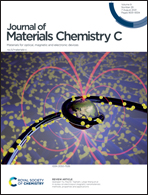Pt-decorated phosphorene as a propitious room temperature VOC gas sensor for sensitive and selective detection of alcohols†
Abstract
Inspired by prior advancements and the growing utilization of two-dimensional (2D)-based gas sensors, this work presents the potential of black phosphorene for sensing volatile organic compound (VOC) gas molecules. First-principles density functional theory (DFT) combined with non-equilibrium Green's function (NEGF) calculations was employed to evaluate the VOC sensing performance of suspended pristine and Pt-decorated phosphorene materials. Several VOCs, such as acetone, ethanol, formaldehyde, methanol, and toluene, along with CO2 and H2O molecules, were considered as the target gases. The results indicated that although the electronic properties of pristine phosphorene were slightly affected by the VOC adsorption, decorating the phosphorene sheet with Pt atoms drastically increased its sensitivity to alcohols. Sensors based on Pt-decorated phosphorene were found to be more sensitive and selective toward methanol among the other considered gas molecules with a gas response of 41.10%. A short recovery time of 0.17 s at room temperature and under UV light was obtained theoretically, and it confirmed the potential application of Pt–phosphorene-based sensors for alcohol detection at room temperature.



 Please wait while we load your content...
Please wait while we load your content...